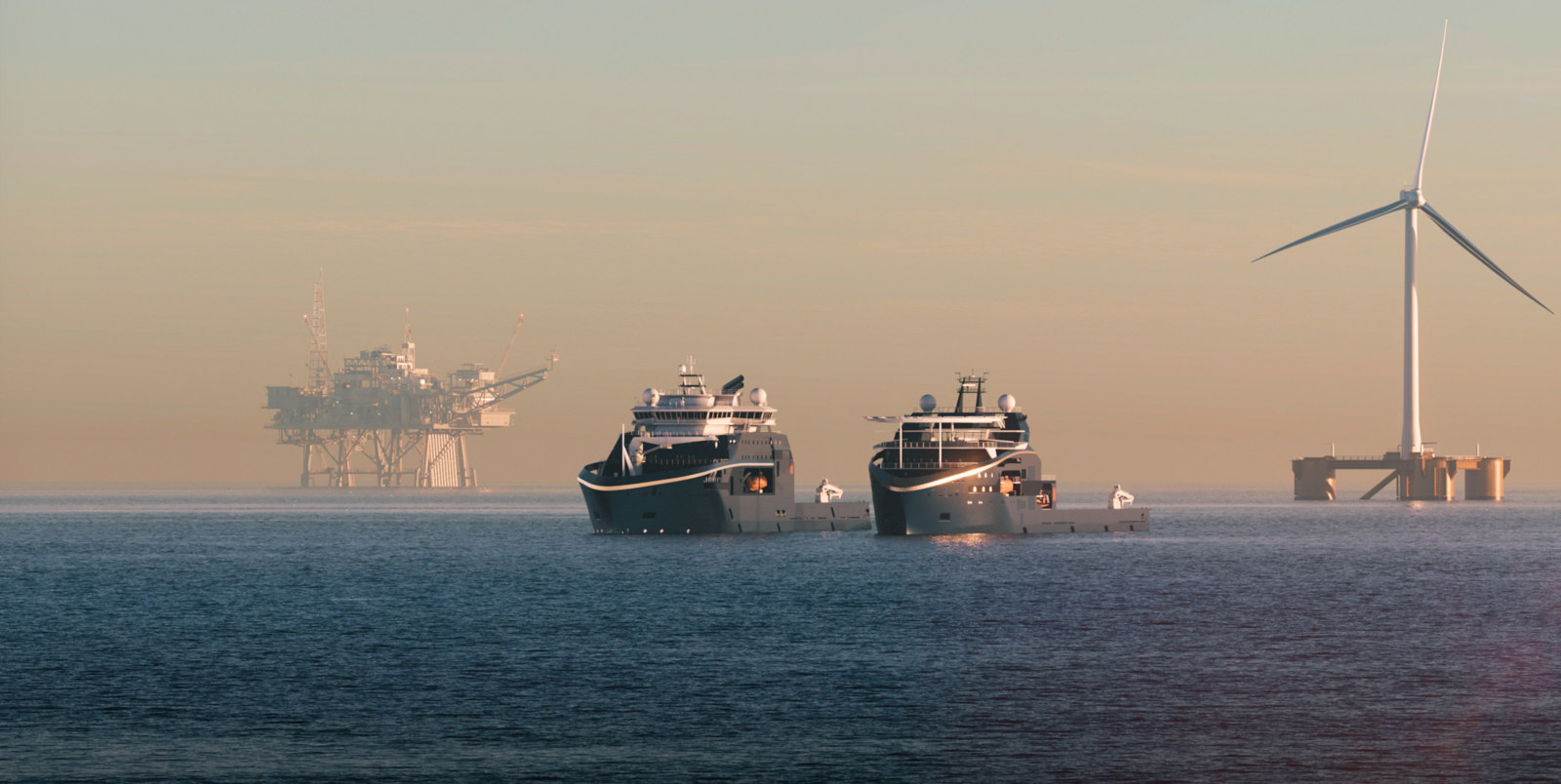
New vessels fit for a green future
The demand for offshore wind farms and cleaner energy is set to grow – as is the need for pioneering transportation, mooring and installation technologies, such as two innovative new FWIVs designed to prioritise safety, efficiency and the environment.
-
Text:Global Sales and Marketing
Photo:©Kongsberg Maritime
-
Craig TaylorSenior Manager PR & Communications
For 50 years, Kongsberg Maritime has been a pioneer of ship design. Now, this innovative spirit is being expanded even further amid efforts to obtain future growth in floating offshore wind farms and subsea construction.
Offshore wind is set to grow rapidly in many parts of the world and the potential growth in larger, floating wind turbines will mean large scale wind farms that require efficient transportation, mooring and installation – for hundreds, and perhaps thousands, of turbines.
Two new vessel types have been designed for large-scale mooring and installation operations and are equally suited to floating wind turbines, other offshore and subsea structures, and structures for oil and gas.

The two vessels can serve new and traditional energies (UT 7900 FWIV AHT and UT 7600 FWIV SUBSEA).
Described in the portfolio as ‘Floating Wind Installation Vessels’, or FWIVs, one of the two designs is an anchor handling vessel designed to handle large dragging anchors with very high forces, as well as implement a novel rope handling logistics set-up that allows large rope storage and simultaneous deck operations.
The new designs will play a key role in enabling the industrialisation of installing floating wind turbines.
The other design is a large subsea construction vessel with mooring system installation capabilities. This version is equipped with systems required to handle, store and deploy chain, various mooring system elements and rope in a safe and efficient manner, similar to an anchor handler. Both designs bridge a gap between traditional anchor handler and subsea construction vessels, as well as extend the vessel design range in vessel size and capacity.
Future-focused portfolio
Kongsberg Maritime unveiled the first part of its new portfolio in 2023, with a range of platform supply (PSV) and anchor handling tug supply designs. All featured a range of technologies for the use of alternative fuels, hybrid operation
and lower emissions. In the case of the anchor handler (AH), an innovative cross-tensioning system for deep sea anchor installation has been incorporated in the new designs, along with other new features, to meet the requirements for seabed
anchoring of floating structures.
The anchor handling version (the UT 7900 FWIV AHT) features the Kongsberg Maritime triple cross-tensioning system, which is able to tension up three mooring system lines in one operation. The system can pull up to 900 tonnes in a single fall configuration with the use of the winch systems and not the propellers.
The key difference is that the triple cross-tensioning capability is for up to three lines rather than the two on the 2023 AHT’s design longitudinal cross-tension system. Martijn De Jongh, Kongsberg Maritime’s Chief Designer, says: “The new designs will play a key role in enabling the industrialisation of installing floating wind turbines. The volume is going to be very high. That’s why we describe this as the industrialisation of mooring installations.
“Whether it’s using suction anchors, ropes or chains, this work will be very repetitive. It’s the same month after month. That is so different from usual offshore oil and gas operations, which are typically about the mooring of a single large unit, then the vessel moves off to another project. We’ve optimised the designs to do this operation efficiently for the long term.”
Safety for crew members working on deck is a key feature of both vessels. For the FWIV AHT version, the set-up of winch and chain storage is very different from classic anchor handlers.
This vessel offers a new approach and, because of the high volume and repetitive nature of the operations, we’ve built in additional rope and chain storage,” Martijn says. “The whole point behind this system is that you deploy the rope while preparing the next one and you do it in a safe environment, which you can’t do on a normal anchor handler because you have rope winches on deck and a danger zone where you can’t have people. We call it Sim-ops –simultaneous operations. It’s all about preparing for the next task.
To enable Sim-ops, the UT 7900 FWIV AHT has a series of reels for the storage of mooring ropes and chains in the bow, forward of the bridge. “This configuration means the whole main deck is a safe area for handling the rope and respooling it, which is done under low-tension,” Martijn says. “The only ‘danger zone’ is around the stern rollers where you have high-tension ropes deploying anchors. You have a clearly defined safe working area and a non-safe working area this is very different for a vessel of this type and offers something new to this emerging growth market.”
The UT 7900 FWIV AHT is a significant step up in size and the capacities are much higher. Martijn adds: “It compares with the Kongsberg Maritime-designed AHTS Island Victory, one of the most successful vessels we’ve ever delivered. It’s the same length but wider at 28 metres. It’s an installation machine. ”The high-thrust propulsion for this large vessel is through a triple azimuth thruster at the stern, which offers enhanced station keeping, high bollard pull of around 300 tonnes and plenty of redundancy for DP operation.
Subsea solution
The second new vessel design evolved from the requirements of owners experienced in subsea construction who wanted the capability for high-volume floating wind installation.
The UT 7600 FWIV SUBSEA is a large subsea vessel with mooring system handling capabilities. The longitudinal cross tensioning is planned on the subsea vessel, with one line going forward and one line going astern. The forward line is fixed and winches pull in the stern line to tension both forward and stern lines.
Martijn describes the ways that owners see the future opportunity with a flexible vessel, saying: “They are telling us they want a subsea construction vessel but also with anchor and mooring handling capabilities built in. “This is a combination of two vessel types and is a result of a major research project we’ve run looking at the long-term requirements of the floating wind market.
“This is the type of vessel that would likely need to be built on speculation but, with such a drive for clean energy worldwide, I’m convinced that the market will be there and very soon.
“This is a vessel that would be heavily utilised throughout the 2030s and if you want a vessel to be operating then, now is the time to be signing contracts.”


